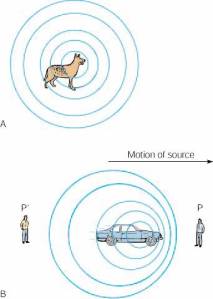
As an ambulance speeds towards you, sirens blazing, the sound you hear is rather high in pitch. This is because the sound waves in front of the vehicle are being squashed together by the moving ambulance. This causes more vibrations to reach your ear per second. As you know, more vibrations per second results in a higher pitched sound. When the ambulance passes you, the sound becomes lower in pitch. Behind the ambulance there are fewer vibrations per second, and a lower sound is heard. This change in pitch is known as the Doppler Effect.
When a vehicle travels faster than the speed of sound, about 330 meters per second, a sonic boom can be heard. As the vehicle overtakes its own sound, the sound waves spread out behind in a shockwave, or sonic boom.

(A) Spherical sound waves from a stationary source spread out evenly in all directions. (B) If the source is moving, an observer at position P will experience more wave crests per second than an observer at position P'. The observer at P interprets this as a higher pitch, and the phenomenon is called the Doppler effect.
Please go to this web site to visualize the Doppler effect.
http://wigner.byu.edu/masong/doppler.html
Please go to the web site
http://library.thinkquest.org/19537/Physics7.html
At that web site
please press the “I” button for more on the Doppler effect
For more information on Sonic booms try
http://www.af.mil/news/factsheets/Sonic_Boom.html.